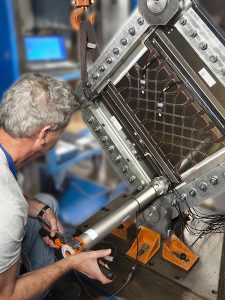Strengthening your competitive edge can sometimes be as simple as it is genius. This is borne out by the portable impactor NLR brought onto the market in 2013.
Every airworthiness certificate includes an accurate estimate of the risk of damage to a new aircraft or helicopter type. If a component wears too quickly and/or shows any signs of structural weakness, flight initiation is postponed. The growing application of composites in the aircraft industry makes it more difficult to predict potential risks, because their exact physical properties are relatively unknown compared to metals, for instance. It is therefore highly important to standardise damage tests, including the exact kinetic data of the object responsible for causing the damage.
To carry out this task, NLR developed the portable impactor, a highly accurate and handy device. It exerts measured impact, enabling its effects to be calculated exactly after the fact. Due to its versatility, the portable impactor is especially handy for exerting impact damage on full-scale aircraft components, including the fuselage and horizontal stabilisers. NLR brought this device onto the market in 2013, in response to widespread international demand.
In a nutshell, the portable impactor consists of a tube with a sliding weight that can forcefully ejected by releasing a powerful spring. Two photocells determine the speed at which the weight travels through the tube, making it easy to calculate the energy of the impact. The built-in data-acquisition system ensures easy administration of test records.
The portable impactor is performing well at NLR, but its success story doesn’t end there. For instance Bombardier, the Canadian business jet and commercial aircraft manufacturer, which now has two NLR-portable impactors in operation. And Airbus also recently approved deployment of the impactor.

